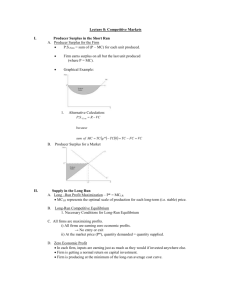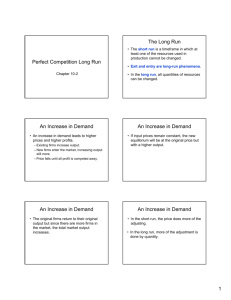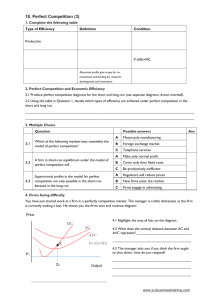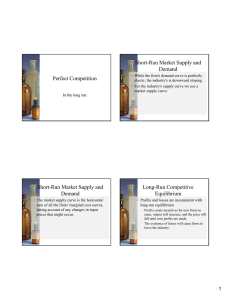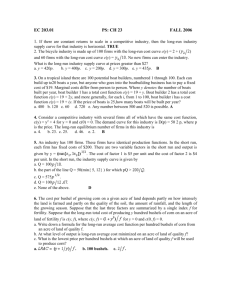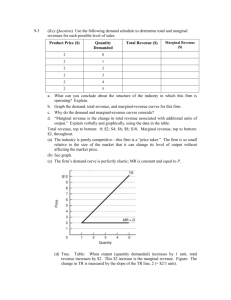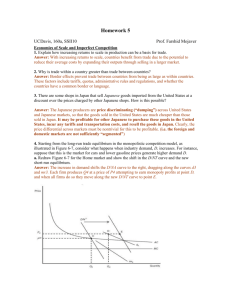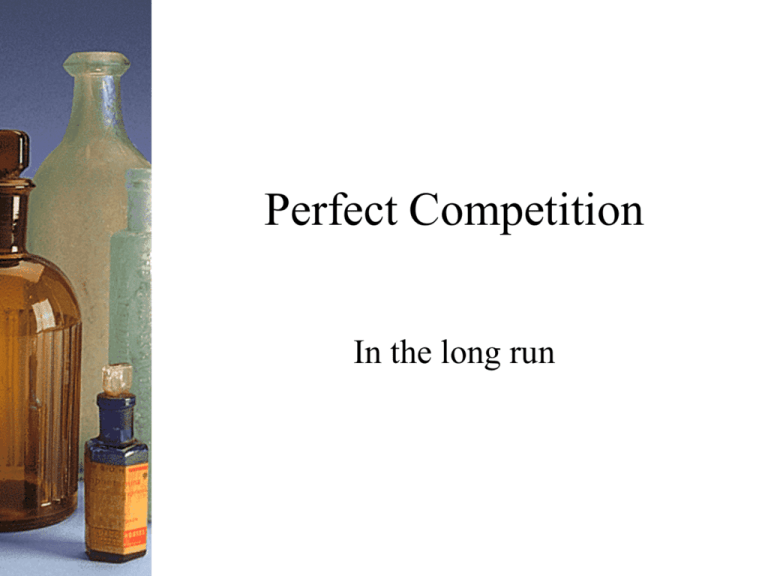
Perfect Competition
In the long run
Short-Run Market Supply and
Demand
• While the firm's demand curve is perfectly
elastic, the industry's is downward sloping.
• For the industry's supply curve we use a
market supply curve.
Short-Run Market Supply and
Demand
• The market supply curve is the horizontal
sum of all the firms' marginal cost curves,
taking account of any changes in input
prices that might occur.
Long-Run Competitive
Equilibrium
• Profits and losses are inconsistent with
long-run equilibrium.
– Profits create incentives for new firms to
enter, output will increase, and the price will
fall until zero profits are made.
– The existence of losses will cause firms to
leave the industry.
Long-Run Competitive
Equilibrium
• Only at zero profit will entry and exit stop.
• The zero profit condition defines the
long-run equilibrium of a competitive
industry.
Long-Run Competitive
Equilibrium
MC
Price
60
50
SRATC
40
P = MR
30
20
10
0
2
4
6
8
Quantity
LRATC
Long-Run Competitive
Equilibrium
• Zero profit does not mean that the
entrepreneur does not get anything for his
efforts.
• Normal profit – the amount the
owners of business would have
received in the next-best alternative.
Long-Run Competitive
Equilibrium
• Normal profits are included as a cost and
are not included in economic profit.
• Economic profits are profits above
normal profits.
Long-Run Competitive
Equilibrium
• Firms with super-efficient workers or
machines will find that the price of these
specialized inputs will rise.
• Rent is the income received by those
specialized factors of production.
Long-Run Competitive
Equilibrium
• The zero profit condition makes the
analysis of competitive markets
applicable to the real world.
• To determine whether markets are
competitive, many economist focus on
whether barriers to entry exist.
Adjustment from the Long Run
to the Short Run
• Industry supply and demand curves come
together to lead to long-run equilibrium.
An Increase in Demand
• An increase in demand leads to higher
prices and higher profits.
– Existing firms increase output.
– New firms enter the market, increasing output
still more.
– Price falls until all profit is competed away.
An Increase in Demand
• If input prices remain constant, the new
equilibrium will be at the original price but
with a higher output.
An Increase in Demand
• The original firms return to their original
output but since there are more firms in the
market, the total market output increases.
An Increase in Demand
• In the short run, the price does more of the
adjusting.
• In the long run, more of the adjustment is done
by quantity.
Market Response to an Increase
in Demand
Market
Price
Price
Firm
S0SR
$9
7
AC
S1SR
B
C
A
SLR
MC
$9
Profit
7
B
A
D1
D0
0
McGraw-Hill/Irwin
700
840 1,200 Quantity
0
1012 Quantity
© 2004 The McGraw-Hill Companies, Inc., All Rights Reserved.
Long-Run Market Supply
• In the long run firms earn zero profits.
• If the long-run industry supply curve is
perfectly elastic, the market is a constantcost industry.
Long-Run Market Supply
• Two other possibilities exist:
– Increasing-cost industry – factor prices rise as
new firms enter the market and existing firms
expand capacity.
– Decreasing-cost industry – factor prices fall as
industry output expands.
An Increasing-Cost Industry
• If inputs are specialized, factor prices are
likely to rise when the increase in the
industry-wide demand for inputs to
production increases.
An Increasing-Cost Industry
• This rise in factor costs would force costs
up for each firm in the industry and
increases the price at which firms earn
zero profit.
An Increasing-Cost Industry
• Therefore, in increasing-cost industries,
the long-run supply curve is upward
sloping.
A Decreasing-Cost Industry
• If input prices decline when industry
output expands, individual firms'
marginal cost curves shift down and the
long-run supply curve is downward
sloping.
A Decreasing-Cost Industry
• Input prices may decline to the zeroprofit condition when output rises.
• New entrants make it more costeffective for other firms to provide
services to all firms in the market.
A Decreasing-Cost Industry
• Decreasing-cost industries have
downward-sloping supply curves.
• The slope of the long-run supply curve
depends on what happens to factor costs
when output increases.
An Example in the Real World
• K-mart decided to close over 300 stores
after experiencing two years of losses (a
shutdown decision).
• K-mart thought its losses would be
temporary.
An Example in the Real World
• Price exceeded average variable cost, so
it continued to keep some stores open
even though those stores were losing
money.
An Example in the Real World
Price
MC
ATC
Loss
AVC
P = MR
Quantity
An Example in the Real World
• After two years of losses, its prospective
changed.
• The company moved from the short
run to the long run.
An Example in the Real World
• They began to think that demand
was not temporarily low, but
permanently low.
• At that point they shut down those
stores for which P < AVC.
Summary
• Competitive firms maximize profit where MR
= MC.
• Profit is P – ATC times output at the profitmaximizing level of output.
• Perfectly competitive firms shut down if P <
AVC.
• The supply curve of a competitive firm is its
MC curve above minimum AVC.
• The short-run market supply curve is the
horizontal sum of the MC curves for all the
firms in the market.
Summary
• In the short run, competitive firms can make a
profit or loss. In the long run they make zero
profits.
• If there are profits:
– Firms enter the industry
– Supply increases
– Price decreases, eliminating profit
• If there are losses:
– Firms leave the industry
– Supply decreases
Summary
• The long-run industry supply curve is a
schedule of quantities supplied where firms are
making zero profit.
• Constant-cost industries have horizontal longrun supply curves.
• Increasing-cost industries have upward sloping
long-run supply curves.
• Decreasing-cost industries have downwardsloping supply curves.
• The slope of the long-run supply curve
depends on what happens to factor costs when



